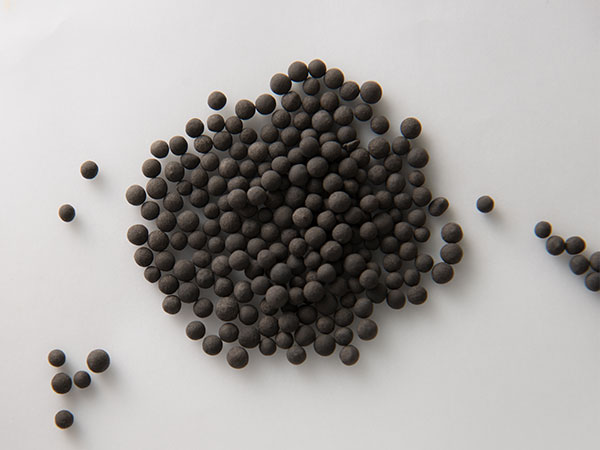Palladium on activated alumina
Palladium on Activated Alumina (Pd/Al₂O₃) catalyst features 0.5–10% Pd loading, high surface area, and fine particle size. It is widely used in selective hydrogenation, dehydrogenation, and hydrogenolysis. Store in a dry, cool place away from moisture and oxidizing agents.
With high purity, customizable specifications, and reliable performance, our Pd/Al₂O₃ catalysts are available for both research and large-scale industrial applications. Contact us to learn more about purchasing palladium on activated alumina catalysts tailored to your specific hydrogenation and chemical processing needs.
| Material | Palladium on carbon, Pd/Al₂O₃ catalyst |
| Carrier/Support | tooth ball, spherical, cylindrical, size 1.5-5mm |
| Carrier material | Alumina, α-type, γ-type, δ-type |
| Appearance | Black ball, White ball |
| Pd content | 5%, 10%, 15%, 20%, customized |
| CAS Number | 7440-05-3 |


Description of palladium alumina catalyst
Palladium on Activated Alumina (Pd/Al₂O₃) is a highly efficient supported catalyst widely used in hydrogenation, dehydrogenation, and hydrogenolysis reactions. It features a customizable palladium loading ranging from 0.5% to 10%, supported on high-surface-area activated alumina with optimized pore structure to ensure excellent dispersion and catalytic activity. Typical surface areas are between 100 and 250 m²/g, and particle sizes can be tailored from 20 to 100 microns based on application needs.
Pd/Al₂O₃ catalysts offer outstanding thermal stability, mechanical strength, and selectivity, making them ideal for industrial gas-phase and liquid-phase reactions. Common applications include selective hydrogenation of alkenes and alkynes, dehydrogenation of hydrocarbons, hydrogenolysis of carbon-heteroatom bonds, and purification of olefins. This catalyst is frequently used in the production of fine chemicals, pharmaceuticals, petrochemicals, and specialty materials. Its reusability and consistent activity over multiple cycles contribute to greater process efficiency and reduced operational costs.
Alumina-supported Pd-based catalysts specifications
CAS No.: 7440-05-3
Palladium content: 0.1%~10%
Carrier material: Alumina
Crystal form of carrier: α-type, γ-type, δ-type;
Carrier shape: tooth ball, spherical, cylindrical, size 1.5-5mm
Specific surface area (m2/g): 95-350
Pore volume (ml/g): 0.45-1.0
Pore size (nm): 5-35
Bulk density (ml/g): 0.42-0.90
Compressive strength (N): 15-90
Application of Palladium on activated alumina Pd/Al₂O₃ catalyst
Hydrogenation catalyst (Pd/Al₂O₃ for olefins, nitro compounds)
Palladium-alumina for automotive catalytic converters
Selective hydrogenation of acetylene to ethylene
Chemical synthesis (pharmaceutical intermediates, fine chemicals)
Environmental catalysis (VOCs abatement, exhaust treatment)
Selective hydrogenation Pd/Al₂O₃ catalyst Scholar Articles
Advances in morphology-controlled alumina and its supported Pd catalysts: synthesis and applications
Abstract: Alumina materials, as one of the cornerstones of the modern chemical industry, possess physical and chemical properties that include excellent mechanical strength and structure stability, which also make them highly suitable as catalyst supports. Alumina-supported Pd-based catalysts with the advantages of exceptional catalytic performance, flexible regulated surface metal/acid sites, and good regeneration ability have been widely used in many traditional chemical industry fields and have also shown great application prospects in emerging fields. This review aims to provide an overview of the recent advances in alumina and its supported Pd-based catalysts. Specifically, the synthesis strategies, morphology transformation mechanisms, and structural properties of alumina with various morphologies are comprehensively summarized and discussed in-depth. Then, the preparation approaches of Pd/Al2O3 catalysts (impregnation, precipitation, and other emerging methods), as well as the metal–support interactions (MSIs), are revisited. Moreover, Some promising applications have been chosen as representative reactions in fine chemicals, environmental purification, and sustainable development fields to highlight the universal functionality of the alumina-supported Pd-based catalysts. The role of the Pd species, alumina support, promoters, and metal–support interactions in the enhancement of catalytic performance are also discussed. Finally, some challenges and upcoming opportunities in the academic and industrial application of the alumina and its supported Pd-based are presented and put forward.
